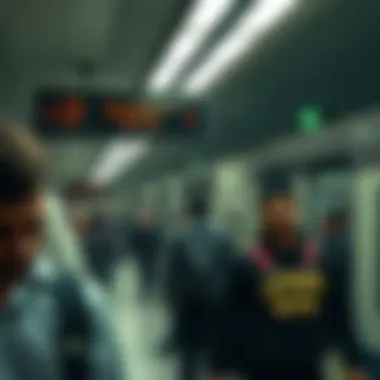Understanding Dubai Metro Working Hours and Impact


Intro
The Dubai Metro has become a lifeline for the city's residents and visitors alike, seamlessly weaving through the urban landscape. Understanding how the operational hours work is essential for those navigating the bustling streets and attractions of this vibrant city. The timings of the metro can significantly impact not just the daily commute but also influence business operations and overall productivity across Dubai.
In this article, we’ll dissect the operational hours of the Dubai Metro, diving into scheduling variations throughout the week and the adjustments made for public holidays. We'll also touch on the broader picture: how the metro enhances connectivity within the city and its implications for commuting patterns and business dynamics in the real estate sector.
Buckle up as we explore an intricately woven narrative where convenience meets connectivity. With insights tailored for investors, homebuyers, and property managers, this will serve as a valuable resource for grasping not just the how of metro working hours but also the why behind it all.
Market Insights
Current Trends in Dubai Real Estate
Dubai's real estate landscape is ever-evolving. The surge in property demand, fueled by robust infrastructure and rapid development, highlights the importance of reliable transportation. With the metro serving as a backbone for commuters, it becomes clear how closely real estate prices are tied to accessibility. Areas such as Dubai Marina and Business Bay, which are easily reachable via metro, showcase higher property values compared to more isolated neighborhoods.
- Proximity to Metro Stations: Properties within walking distance of a metro station significantly outperform those further away.
- Rental Rates: As more professionals opt for metro commuting, rental rates in metro-adjacent areas continue to climb.
The metro is not merely a means of transportation; it shapes the very fabric of Dubai's urban development.
Analysis of Future Predictions
Looking ahead, experts foresee continued growth in areas serviced by the metro system. As Dubai positions itself as a global hub, the demand for properties near metro lines is expected to rise. Key elements driving this prediction include:
- Expo 2020 Legacy: As events like Expo 2020 leave a lasting imprint, properties close to metro stations are predicted to sustain their value.
- Increased Connectivity Projects: Planned expansions of the metro network are slated to enhance accessibility, further elevating property values in fringe areas.
- Sustainability Focus: With a growing emphasis on sustainable living, the convenience of metro commuting attracts eco-conscious buyers and renters.
As these trends unfold, both investors and homebuyers will need to recalibrate their strategies to align with the changing dynamics of the market.
Investment Strategies
Tips for First-Time Investors
Navigating the real estate waters can be tricky, especially for newcomers. Here are some tips for those looking to dip their toes in Dubai's real estate:
- Do Your Research: Familiarize yourself with different neighborhoods and their relation to metro services.
- Consider Future Developments: Pay attention to planned metro expansions that could increase property appeal.
- Engage Experts: Consult with local real estate agents who understand the metro's impact on property value.
Understanding Property Valuation
Understanding how the metro influences property valuation is crucial. Key factors include:
- Accessibility: Properties with good metro access are generally valued higher due to increased demand.
- Amenities: Proximity to metro stations often means easier access to shops, restaurants, and parks, enhancing property value.
- Market Trends: Regularly reviewing market reports can help gauge the potential rise or fall in property values tied to metro accessibility.
For more in-depth insights, feel free to check out resources such as Wikipedia and Britannica which provide extensive information on the metro system and its impact on the city.
By understanding these intricate ties between the metro operational hours and real estate dynamics, stakeholders can make informed decisions that align with their investment goals while contributing to the sustainable development of a city on the rise.
Prelims to Dubai Metro
The Dubai Metro has revolutionized the urban landscape of the city, significantly altering the dynamics of transportation within this bustling metropolis. With its extensive network and cutting-edge technology, it serves as a vital artery for commuters, linking key areas and providing easy access to the numerous attractions that Dubai has to offer. The significance of the metro cannot be overstated; it has become a lifeline for both residents and visitors, alleviating traffic congestion while promoting a more sustainable form of travel.


Historical Context
The inception of the Dubai Metro dates back to the early 2000s, when rapid urbanization prompted the government to establish an efficient public transport system. Initially launched in 2009, the metro's development marked a turning point for Dubai’s urban infrastructure. The project was designed not only to address the city's growing transportation needs but also to demonstrate its ambition on the global stage. Constructed with a vision to incorporate advanced technology, the metro offers an electric train system that operates entirely without a driver, thus showcasing advanced engineering feats. This historical backdrop cements the metro's role as more than just a transport solution; it’s a symbol of the city's progress and modernization efforts.
Importance for Urban Transportation
The Dubai Metro plays a crucial role in enhancing urban mobility and shaping the city’s transport ecosystem. Here are some ways it has contributed:
- Reducing Traffic Congestion: The metro provides an alternative to private vehicles, effectively reducing the number of cars on the road. This shift not only lessens traffic congestion but also decreases environmental pollution associated with high traffic volumes.
- Increasing Accessibility: Stations are strategically placed near residential and commercial areas, making it easier for workers and residents to commute. With stops near major landmarks, such as the Mall of the Emirates and Dubai Mall, it offers a seamless connection to the city's attractions.
- Supporting Economic Growth: By facilitating efficient transport for thousands of daily commuters, the metro promotes local businesses and real estate development. Proximity to metro stations often translates to increased property values, making it appealing for both investors and homebuyers.
- Encouraging Sustainable Practices: The emphasis on public transit as a primary mode of travel encourages a car-free lifestyle for many, supporting broader environmental goals in the region. As Dubai continues its journey toward sustainability, the metro serves as a significant part of that vision.
Understanding Metro Working Hours
Understanding the metro working hours is crucial for anyone navigating Dubai's vibrant urban landscape. This section offers insights into the operational schedule of the Dubai Metro, a key component of the emirate’s public transport system. Knowing the timings not only assists commuters in planning their journeys but also impacts local businesses and economic activities. The operational hours dictate the flow of daily life in Dubai, affecting everything from peak traffic levels to service provision in shops and offices.
Regular Operating Schedule
The regular operating hours of the Dubai Metro reflect the rhythm of city living. Typically, the metro runs from 5:00 AM to midnight from Saturday to Thursday, while on Fridays, it operates from 8:00 AM to midnight. This schedule allows early risers to catch a train before the break of dawn and supports late-night travelers returning home after a busy day. The clear demarcation of hours enhances predictability for commuters.
A closer look at the regular schedule reveals its alignment with the work week in Dubai, which runs from Sunday to Thursday. This means that during these days, the peak hours usually occur between 7:00 AM to 9:00 AM and 5:00 PM to 8:00 PM. Knowing these times can help commuters avoid congestion and make for smoother travel experiences.
- Sunday to Thursday: 5:00 AM - 12:00 AM
- Friday: 8:00 AM - 12:00 AM
- Saturday: 5:00 AM - 12:00 AM
It’s worth mentioning that these hours could be subject to change based on operational contingencies, so staying updated through official channels is wise.
Weekend Variations
During weekends, the metro's operational hours shift slightly to accommodate the different lifestyle patterns of residents and tourists. On Fridays, trains start later at 8:00 AM, reflecting the cultural practice of attending congregational prayers during the morning hours. The extended working hours on Saturday mirror those of weekdays, maintaining accessibility for lively weekend activities.
For those enjoying the leisure of Dubai during weekends, the metro provides a reliable mode of transportation to popular spots, shopping malls, and entertainment hubs. Understanding these weekend variations can significantly enhance weekend plans, allowing for maximum enjoyment without clock-watching.
Public Holidays and Special Events
Public holidays in Dubai often lead to changes in metro working hours. Major holidays such as Eid, National Day, and even New Year’s Eve see the metro operating on altered hours, often extending service to accommodate increased passenger volumes. For instance, around these holidays, it's common for the metro to extend operations into the early hours of the morning, catering to celebrants and night owls.
Special events, like city-wide festivals or exhibitions, also influence the metro schedule. Enhanced frequency may be introduced to shuttle an influx of visitors to key locations such as the Dubai Exhibition Centre or Dubai Mall. Timely announcements through the RTA’s official channels or their social media platforms provide necessary updates, allowing commuters to plan their travels effectively around these special times.
"Staying informed about changes in metro hours can transform your travel experience from a mere task into a seamless part of the day."
Impact on Commuters
Understanding the impact of the Dubai Metro on commuters is crucial for recognizing how the system shapes daily life in this bustling city. The metro isn’t just a mode of transit; it serves as a backbone for the city’s connectivity, playing a significant role in facilitating the movement of millions. For many, the metro represents not only a convenient alternative to road travel but also a catalyst for economic and social interaction.
Regular commuters often align their schedules around the metro's operating hours. This alignment produces clear commuting patterns that reflect how people use the metro to maximize productivity while navigating work and leisure activities.
Furthermore, the reliance on the metro varies across different demographics. Tourists, for instance, may utilize it more for exploration, while daily workers depend on it to get from point A to point B efficiently. This variation in usage highlights the adaptability of the metro as a public transportation option catering to diverse needs.
"The Dubai Metro has transformed the commuting landscape, turning long wait times into smooth, predictable journeys that ripple through the city’s economy."
Commuting Patterns


When analyzing commuting patterns, one finds that the peak usage hours correlate closely with standard business hours. Typical morning rush hours begin around seven and remain busy until about nine. The evening rush returns from four until six. This consistent rhythm underlines a well-coordinated system where both workers and offices fall into a synchronized flow.
Notably, the metro attracts various user segments. Business professionals often prefer using it to avoid the ceaseless traffic jam s on Sheikh Zayed Road, while students rely on it to reach educational institutions efficiently. During weekends, the commuting patterns shift slightly as leisure travelers take center stage, visiting malls, parks, and cultural sites.
Supporting this, the introduction of affordable all-day passes and bulk ticket options has made the metro more accessible for families and groups, further changing the pattern of usage. In essence, the metro morphs based on the week and time of day, reflecting the underlying socioeconomic fabric of Dubai.
Challenges Faced by Commuters
Despite its many benefits, the Dubai Metro system does present some challenges for commuters. One major issue is overcrowding during peak hours. With the metro's popularity, trains can become packed like sardines, particularly on popular lines—such as the Red Line. Commuters often have to engage in a waiting game, especially when trying to board during rush hour.
Also, interlinking connections with other forms of public transport, like buses or taxis, can sometimes create confusion. Not every station has a seamless transfer option, which can add unnecessary stress for those who rely on multiple modes of transport to reach their destinations.
Moreover, while the metro timetable is fairly reliable, occasional delays can disrupt even the best-laid plans. Commuters need to stay abreast of operational updates through various channels, which can be a hassle amidst busy daily lives.
To sum it all up, while Dubai Metro stands as a pinnacle of urban transportation infrastructure, the experience can be mixed. Addressing these challenges can further enhance the overall effectiveness of this vital transit system, and ultimately contribute to a more efficient commuting environment.
Effects on Local Economy
The operational hours of the Dubai Metro have a substantial impact on various facets of the local economy, influencing everything from daily commuting rhythms to long-term real estate trends. The Metro isn’t simply a means of transport; it plays a pivotal role in shaping the commercial landscape of the city. Understanding this connection is essential for investors, homebuyers, and property managers, as it reveals how the timing and adaptability of transit systems can drive economic success.
Business Accessibility and Growth
The correlation between metro operating hours and business accessibility is quite pronounced. Longer operational hours naturally extend the window for potential customers to patronize businesses near metro stops. In bustling business districts like Downtown Dubai or Jumeirah Lakes Towers, having the Metro run early in the morning and late into the evening allows employees to work more flexible hours, promoting a culture of productivity.
Consider a café situated within walking distance of a metro station. If the Metro runs until midnight, it’s not just feasible for workers to grab a coffee post-work; it invites night owls and tourists alike. This boosts foot traffic significantly, translating into increased sales for local businesses.
Moreover, small enterprises and startups, often dependent on local patronage, benefit from heightened accessibility. If the Metro can accommodate various shifts, it reduces barriers for employees getting to work, encouraging hiring and hence fostering growth.
Real Estate Development Near Metro Stations
Real estate development near metro stations often mirrors the efficiency and reliability of the transport system. When planning a move or investment in the Dubai property market, understanding these dynamics is crucial. Properties situated close to metro stations tend to see an uptick in demand, driving prices higher. This phenomenon occurs because accessibility becomes a critical factor in buyers' decisions.
Investors looking at residential or commercial properties need to consider the following:
- Proximity to Metro Stations: Properties close to metro entrances often see faster appreciation.
- Future Developments: Areas earmarked for new metro stations often experience preliminary investment booms, as savvy buyers anticipate future demand.
- Urban Planning Initiatives: The Dubai government consistently integrates metro lines into its urban planning, enhancing overall livability in surrounding areas, thus creating attractive spaces for residential and commercial ventures.
As a situation of supply and demand, properties near transit hubs become gold mines for investors. Those who can see this trend early stand to capitalize on the flourishing nature of urban living in Dubai, where connectivity and convenience are paramount.
"The presence of a metro station increases property values by an estimated 10 to 20% in cities globally."
When considering investment in Dubai’s real estate, the operational hours of the Metro illustrate not just the present value, but forecast the future landscape of urban living and working trends in this vibrant city.
Safety and Efficiency of Metro Operations
In discussing the operational aspects of the Dubai Metro, the twin concepts of safety and efficiency cannot be overstated. They play a pivotal role not only for commuter confidence but also for the overall success of the public transportation system. Ensuring that passengers feel secure while also optimizing travel times contributes significantly to the metro's reputation and effectiveness.
Safety Protocols


The realm of safety within the Dubai Metro is extensive and meticulously designed. Various safety protocols are implemented to guarantee that every ride is devoid of accidents and mishaps. Some safety features include:
- Surveillance Systems: Advanced CCTV cameras are installed throughout stations and on trains. These systems monitor activity and enhance security.
- Emergency Procedures: Comprehensive emergency response plans are in place. Staff members are trained regularly to handle situations like evacuations or medical emergencies.
- Regular Inspections: Metro systems undergo routine checks to ensure that trains, tracks, and infrastructure are maintained to the highest standards of safety.
Furthermore, the training period for metro staff is rigorous, emphasizing public safety and customer service. This proactive approach not only safeguards passengers but also helps to build unwavering trust in the metro system.
"Safety in transit is not just a goal; it’s a fundamental right for every commuter."
Timeliness and Reliability
Another critical aspect of the metro's operations is its timeliness and reliability. The efficiency of any public transport system is primarily gauged by its ability to meet schedules consistently. In the case of the Dubai Metro, punctuality is key.
Commuters often rely on trains to arrive at their destinations on time, which can impact their daily routines. The Dubai Metro boasts a commendable performance in this area through:
- Punctual Departure and Arrival: Aiming to keep trains on a strict timetable minimizes waiting times, improving overall efficiency in urban commutes.
- Real-Time Updates: Digital screens display real-time information at stations, allowing passengers to plan accordingly.
- Streamlined Operations: By employing automated systems, the metro can efficiently manage train frequencies and adjust services based on commuter demand.
In summary, the adherence to safety protocols and the commitment to timely service establishes the Dubai Metro as a critical player in the emirate's urban landscape. Commuters are not just passengers; they are participants in a well-oiled machine that facilitates not only their travel but also serves as the backbone of Dubai's evolving public transport framework.
Future Prospects
The future of the Dubai Metro is a topic that carries significant weight in discussions about urban development and public transit efficacy. As Dubai continues to grow and evolve, the metro system will undoubtedly play a pivotal role in shaping the city’s transportation landscape. This section delves into the planned expansions and upgrades of the metro system, and how adjustments to working hours could further enhance commuter experiences while driving business growth. Understanding these aspects is essential for stakeholders—investors, homebuyers, and property managers—who can benefit from insights into the metro's trajectory.
Planned Expansions and Upgrades
Signaling a commitment to continuous improvement, the Dubai Metro is slated for various expansions and upgrades. These plans aim to connect more neighborhoods and reduce congestion on the existing lines. Among the most notable projects is the extension of the Red Line, which is expected to reach the suburban areas of Dubai, enhancing accessibility for residents in those regions. Another ambitious endeavor includes the introduction of new stations that will link up with key economic zones and tourism hubs.
Some specific highlights of these future expansions are:
- New Lines: The introduction of additional metro lines to accommodate the increasing population.
- Enhanced Capacity: Upgrades to existing trains to allow for greater passenger capacity and faster service.
- Integration with Other Transportation Modes: Plans to create seamless connectivity with buses, taxis, and even air transport at select hubs, making it easier for commuters to transfer between services.
Moreover, as technology advances, there is an interest in incorporating smart systems into operations. The potential for apps that provide real-time updates can significantly enhance commuter convenience by minimizing wait times and optimizing routes. All these expansions show a commitment to not just keeping pace with growing demand but to setting a standard in urban transit systems.
Adjustments to Working Hours
As the UAE adjusts its working hours due to cultural norms and economic demands, understanding the implications for metro operations is crucial. The Dubai Metro is agile and has previously demonstrated flexibility in modifying its schedule to accommodate peak hours, considering factors like business hours, school schedules, and even seasonal variations.
Commuters can expect the following adjustments in working hours:
- Early Openings: Extended service hours during major events or festivals, ensuring that late-night travelers have access to safe and efficient transport.
- Flexibility on Weekends: Altered schedules that mirror the leisure and shopping patterns of residents and tourists, allowing for better service on Fridays and Saturdays when demand typically spikes.
- Public Holiday Considerations: Adjustments to accommodate for increased travel during holidays, reflecting the city's dynamic culture and tourism influx.
These adjustments not only enhance the commuter experience but also serve to fortify the local economy by ensuring that businesses can operate effectively during peak customer hours. Stressing on connectivity, the Dubai Metro is poised to remain a vital artery of movement, interfacing directly with the lives of residents and visitors alike.
"Public transport is not just about moving people; it's about fostering connections that drive a city forward."
Ending
In wrapping up the discussion on Dubai Metro working hours, it’s crucial to grasp how these hours ripple through the urban fabric of the city. The metro system’s operational schedule not only reflects the daily rhythm of life in Dubai but also plays a significant role in shaping commuting patterns, business accessibility, and the broader economy.
Summary of Key Points
- Regular hours of operation provide a structured travel experience for thousands of commuters daily, reinforcing the significance of public transportation in urban settings.
- Weekend variations in scheduling offer flexibility for leisure travelers, highlighting the metro’s dual role as a transport service and a leisure facilitator.
- Public holidays and special events witness adjusted hours, ensuring that the metro serves as a reliable option during peak travel times, catering to both visitors and residents.
- Trends in real estate development near metro stations underline the critical connection between transit accessibility and property value, making an understanding of working hours vital for investors and homebuyers alike.
Final Thoughts on Metro and City Dynamics
As the Dubai Metro continues to evolve, its working hours will likely adapt further to meet the city's needs. This will not just influence transit efficiency, but it will also ripple out to impact local commerce, real estate ventures, and the overall lifestyle of Dubai’s inhabitants. A flexible and responsive metro schedule can enhance productivity for commuters while simultaneously boosting local economies. In essence, understanding these dynamics is pivotal for anyone looking to invest or engage within this vibrant metropolis. Keeping a pulse on metro operations can offer crucial insights into the city's growth trajectories and investment opportunities.















